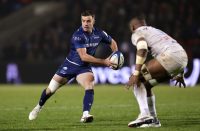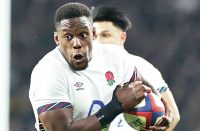 Slabs of red meat? More like slabs of gristle. The sort of tough, unpalatable stuff that the Aussies, who like the red meat on their barbies to be soft and juicy, will not relish getting their chops around.
Slabs of red meat? More like slabs of gristle. The sort of tough, unpalatable stuff that the Aussies, who like the red meat on their barbies to be soft and juicy, will not relish getting their chops around.
That’s why the predictable outbreak of Aussie sledging that accompanied the announcement of the 37-man Lions squad in the leafy, tranquil surroundings of Syon Park in south west London earlier this week, smacked more of apprehension than deep-rooted confidence.
It will probably be the only thing that is tranquil about the monstrous regiment of red shirts that will make landfall in Australia at the start of next month. The 2013 tourists are physically the biggest side to have represented the British & Irish Lions, and the size of them has already forced the tribe Down Under to pause for thought.
It is a given that the Wallabies will run pretty patterns if they get the chance, with such gifted footballers as Will Genia, Kurtley Beale, Quade Cooper and James O’Connor to call on. But the key to the series will be whether they get that chance often enough.
The Lions head coach, Warren Gatland, has made no secret of his intention to launch a head-on assault, and he has picked a squad with the size and physicality to apply set-piece pressure, dominate the collisions, and get the upper hand at the breakdown.
Only four of the 37 are under 6ft. Backs Leigh Halfpenny, Brian O’Driscoll and Ben Youngs are 5ft 10ins, while Tom Youngs is the shortest player in the squad at an inch less. Although the Leicester hooker is as wide as he is tall, he is also the lightest forward, at just over 16st, while full-back Stuart Hogg is the lightweight among the backs at 13st 12lb.
Apart from that, we are in the land of the giants. The remaining 33 have height, muscle, power and pace everywhere. Two of the scrum-halves, Mike Phillips (6ft 3in, 16st 5lb) and Conor Murray (6ft 2in, 15st), are built more like back row forwards, and the same is true of fly-halves Jonathan Sexton (6ft 2in, 14st 5lb) and Owen Farrell (6ft 2in, 15st 2lb).
There are a couple of titans at centre in Jamie Roberts (6ft 4in, 17st 6lb) and Manu Tuilagi (6ft 1in, 17st 9lb), while Sean Maitland is the smallest wing at 6ft 2in, with the two Welsh striker runners, Alex Cuthbert (6ft 6in) and George North (6ft 4in, 17st 6lb), the biggest.
And those are just the backs.

Lock Richie Gray tops the tale of the tape in the forwards at 6ft 10in and 18st 12lb, but prop Matt Stevens is the heaviest at 19st 9lb. Meanwhile, the smallest forward in the back five of the scrum is the Lions captain, flanker Sam Warburton, who is 6ft 2in and 15st 10b.
It is a formidable array of physical firepower, and, while the Lions will have the bigger guns up front, the
differential between Warburton’s forwards and their Wallaby counterparts is nowhere near as pronounced as it is in the backs.
The Australian coach, Robbie Deans, has no-one of the size of Roberts, Tuilagi and North, and even though Israel Folau, the star convert from Rugby League via Aussie Rules, is tall, he is a relatively light at 15st 6lb.
Gatland knows that the Australians will tackle themselves to a standstill, and that is exactly what he intends to make them do. Then, when the fatigue sets in, he will launch even more big power runners off the bench to finish the job.
The idea, however, that the Lions will simply be a one-dimensional bunch of bangers, who stick their heads down and run straight into contact, is wishful thinking on the part of the Wallabies.
Over the years Gatland has proved himself to be one of the most resourceful, innovative coaches in either hemisphere, and his teams have invariably been attacking and good to watch. It is unlikely that the 2013 Lions will depart significantly from the script he wrote for Wasps, and is still writing for Wales.
Deans commented soon after the squad was released that, having seen the Wales-England Six Nations decider, he was expecting the Lions to attempt to smash Australia into submission.
“The best insight of what this series is going to be like was that final Six Nations fixture. It was brutal and it was relentless for 80 minutes,” he said.
However, it was also decided by two good tries, with the ball moved crisply to the touchline, highlighting Justin Tipuric’s openside linking ability and Cuthbert’s impressive finishing skills.
There have been some rumblings that this squad is too Welsh, but how can you argue against
talented players who have won two Six Nations titles in succession, including a Grand Slam, and should have been 2011 World Cup finalists?
Wales deserved the lion’s share, and Gatland’s experience coaching in England and Ireland will be a buffer against any parochialism.
This will be reinforced by the fact that his coaching team is also laced with former Lions in Rob Howley (backs), Graham Rowntree (forwards) and Neil Jenkins (skills), and it should ensure that the mix of 15 Welsh, 10 English, nine Irish and three Scots blends together quickly into a single united force. However, it is rare that a Lions selection meets with universal approval, and the 2013 squad is no exception to the rule.

As a starting point I have little doubt that the Lions front row that the Wallabies wanted to avoid at all costs was Andrew Sheridan, Richard Hibbard and Adam Jones.
The fact that Sheridan is missing makes it a red-letter day for the Aussie grunts. It is also mysterious given that he has been in exceptional form for Toulon, not only keeping Gethin
Jenkins out of the starting line-up but putting Matt Stevens – one of the Lions surprise call-ups – into reverse gear at most of the scrums in their recent Heineken Cup semi-final victory over Saracens.
The idea that Sheridan is an immobile strongman who does not bring enough added extra as a carrier or a defender is not supported by the video evidence of his uninterrupted season in Toulon colours.
Nor is it guaranteed that Toulon will win their Top 14 semi-final, in which case the English loosehead would have been free to fly to Hong Kong. However, despite being an in-form Test Lion, he was deemed surplus to requirements.
Dylan Hartley’s inclusion, giving England two of the hookers in the party, was also controversial, especially as it came at the expense of the experienced, consistent Irish No.2, Rory Best. The Northampton man’s form has been mixed, and, after being injured, it explained why he was bumped from the England berth by Tom Youngs.
Chris Robshaw’s omission from the back row was also a talking point, with Rowntree saying that he was not looking forward to the imminent discussions he would have with deeply disappointed England players.
However, whether it was with Robshaw, Tom Wood or Joe Launchbury, at least Rowntree could point to the 30-3 defeat in Cardiff by way of explanation.
The timing issues that apply to Sheridan are the same that ruled Jonny Wilkinson out of the frame. The difference is that Wilkinson’s immaculate 24-point winning haul against Saracens at least earned him a last-minute phone call from Gatland to sound out his availability for Australia.
Although Wilkinson told him that Toulon was his first responsibility, the general consensus was that the World Cup-winning fly-half would be the first name on the standby list, and rightly so. He might have competition from another surprise absentee, James Hook, not least because the multi-
talented Welshman covers so many backline positions – however, when it comes to closing out tight Test matches, Wilko has no peers.
Howley defended the decision not to take a utility back despite the thin midfield cover, saying that the two fly-halves needed as much game time as possible. He argued also that Stuart Hogg, the versatile 20-year-old Scottish full-back, had broad enough shoulders to fill in at No.10 when needed.
Howley played the versatility card again when he was asked about the selection of three outside centres – O’Driscoll, Tuilagi, above, and Jonathan Davies – to Roberts as the sole inside centre.
“Is it essential to have a specialist? Not really. For instance, Tommy Bowe played 13 against South Africa in the third Test but had never played there before. That’s the beauty of the Lions, they are such talented players that they are able to adapt to what is required.”
He added that he believed both O’Driscoll and Davies were capable of playing 12 and was looking forward to the best of the best competing against each other inside the squad, and learning from it.
“All the backs selected are number one for their country. The competition for places is so important – it is key for the Lions. The midweek team will drive Test match performance, and we will give all players the chance to put their hands up.”
It was, said Howley, a squad selected on the three ‘Ps’: Pedigree, Pace and Power. He could have added a fourth – Physique. Now comes the difficult bit of pulling those components together effectively enough to give the Wallabies a pasting.






















